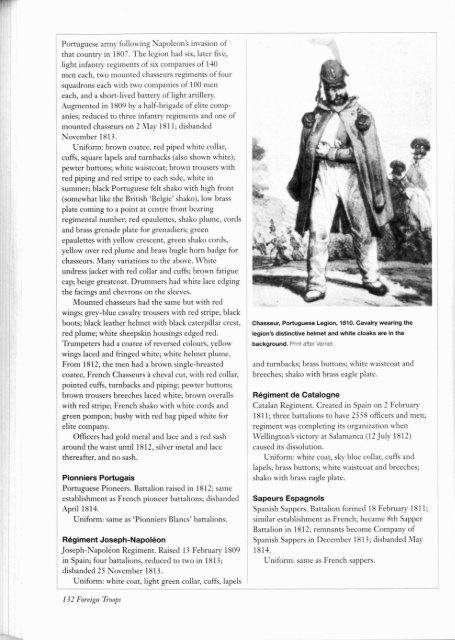You also want an ePaper? Increase the reach of your titles
YUMPU automatically turns print PDFs into web optimized ePapers that Google loves.
Portuguese army following <strong>Napoleon's</strong> invasion ofthat COWltry in 1807. The legion had six, later five,light infantry regiments of six companies of 140men each, two mowned chasseurs regiments of foursquadrons each with two companies of 100 meneach, and a short-lived battery of light artillery.Augmented in 1809 by a half-brigade of elite companies;reduced to three infantry regiments and one ofmounted chasseurs on 2 May 1811; disbanded1 ovember 1813.niform: brown coatee, red piped white collar,cuffs, square lapels and turnbacks (also shown white);pewter buttons; white waistcoat; brown trousers withred piping and red stripe to each side, white insummer; black Portuguese felt shako with high front(somewhat like the British 'Belgic' shako), low brassplate coming to a point at centre front bearingregimental number; red epaulettes, shako plume, cordsand brass grenade plate for grenadiers; greenepaulettes with yellow crescent, green shako cords,yellow over red plume and brass bugle horn badge forchasseurs. Many variations to the above. VVhiteundress jacket with red collar and cuffs; brown fatiguecap; beige greatcoat. Drummers had white lace edgingthe facings and chevrons on the sleeves.Mounted chasseurs had the same but with redwings; grey-blue cavalry trousers with red stripe; blackboots; black leather helmet with black caterpillar crest,red plume; white sheepskin housings edged red.Trumpeters had a coatee of reversed colours, yellowwings laced and fringed white; white helmet plume.From 1812, the men had a brown single-breastedcoatee, French Chasseurs 11 cheval cut, with red collar,pointed cuffs, turnbacks and piping; pewter buttons;brown trousers breeches laced white; brown overallswith red stripe; French shako with white cords andgreen pompon; busby with red bag piped white forelite company.Officers had gold metal and lace and a red sasharound the waist until 1812, silver metal and lacethereafter, and no sash.Pionniers PortugaisPortuguese Pioneers. Battalion raised in 1812; sameestablishment as French pioneer battalions; disbandedApril 1814.Uniform: same as 'Pionniers Blancs' battalions.Regiment Joseph-NapoleonJoseph-Napoleon Regiment. Raised 13 February 1809in Spain; four battalions, reduced to two in 1813;disbanded 25 1 ovember 1813.Uniform: white coat, light green collar, cuffs, lapelsChasseur, Portuguese Legion, 1810. Cavalry wearing thelegion's distinctive helmet and white cloaks are in thebackground. Print after Vernel.and turnbacks; brass buttons; white waistcoat andbreeches; shako with brass eagle plate.Regiment de CatalogneCatalan Regiment. Created in Spain on 2 February1811; three battalions to have 2558 officers and men;regiment was completing its organization whenvVellington's victory at Salamanca (12 July 1812)caused its dissolution.Uniform: white coat, sky blue collar, cuffs andlapels; brass button; white waistcoat and breeches;shako with brass eagle plate.Sapeurs EspagnolsSpanish Sappers. Battalion formed 18 February 1811;similar establishment as French; became 8th SapperBattalion in 1812; remnants become Company ofSpanish Sappers in December 1813; disbanded May1814.niform: same as French sappers.Pionniers, Ouvriers EspagnolsBattalion of Spanish Pioneers and two Companies ofSpanish Artisans. Formed in Holland from SpanishP.O.\,v,s 10 March 1812; disbanded 25 November1813; reorganized as Regiment of Spanish Pioneers(Regiment de pionniers espagnols) on 24 December1813; disbanded 17 April 1814.Uniform: grey round jacket with blue collar, cuffsand lapels, yellow piping; grey greatcoat. Armed onlywith a hanger and a pioneer's tool.Bataillons de Pionniers EspagnolsTwo Spanish Pioneer Battalions formed in January1814 with renmants ofK.ingJoseph's Spanish armywhich had fled to France; disbanded 1st and 6 August1814.Uniform: probably the all light grey-blue dress ofthe 'Pionniers Blancs' if they received one.Other Spanish UnitsThere were also some contra-guerrilla units in Frenchpay raised especially in Catalonia among Miqueletsmountaineers. They generally wore a brown roundjacket and trousers with red collar, cuffs, stripes andsashes, rowld hat with tricolour cockade. MarshalSuchet raised the 'Guides Catalans' in 1810 which had50 mounted and 100 infantrymen for escorts. Theyhad a blue coatee, single breasted, blue pointed cuffsand turnbacks, medium green collar, yellow piping infront, at cuffs, collar and turnbacks; pewter buttons;white waistcoat and breeches; plain bicorn; boots andsabres for mounted men, gaiters and muskets forinfantry. In 18 J3, the Independent Company of A1avaInfantry was formed by pro-French Spaniards. Theuniform was in the French 1812 style but browncoatee with red collar, cuffs, lapels and turnbacks;pewter buttons; brown trousers; shako.Regiment LithuanienLithuanian Regiment. Infantry regiment created 20September 1812; had Polish and French officers;dissolved in late 1813.Uniform: blue kurta, yellow collar, pointed cuffs,lapels and turnbacks; white metal buttons; bluepantaloons with yellow stripe; czapska with bluecrown, yellow piping and band, white metal sl1llriseplate with brass badge (Lithuania's national insignia:an armed horseman), white cockade with white metalPolish cross, company pompon. Grenadier in 1813had bearskin cap, uniform completely blue with yellowlace edging collar, cuffs, lapels; white epaulettes; bluepantaloons with white stripe.Gendarmes LithuaniensLithuanian Gendarmes. Organised in 1812 during theinvasion of Russia to keep some law and order alongthe French lines of communications; proved to beexcellent cavalry and charged at Borodino; retreatedwith French Army in Russia and about 200incorporated into 1st Polish Lancers in 1813.Uniform: blue single-breasted coatee with redcuffs, collar, Ulrnbacks and piping in front, whitetrefoils and aiguillette; pewter buttons; white or bluebreeches; high boots; white belts; bicorn edged withwhite lace; blue housings laced white with whitegrenade; red over white lance pennon.Foreign Regiments of 1815Back in Paris from Elba, Napoleon disbanded theSwiss troops on 2 April 1815 and the next daysuggested the reorganization of Foreign troops intofive regiments, each of three battalions. The decrees of11 and 25 April and of 20 May created eight: 1st(Piedmontese, organized at Chiilon-sur-Soane); 2nd(Swiss, Vitry), 3rd (Polish, at Reims), 4th (German, atTours), 5th (Belgian, at Amiens), 6th (Spanish andPortuguese, at Lorient from the former 'RegimentColonial Etranger'); 7th (Irish, at Montreuil-sur-Mer);8th (Italian, at Aix). Only the 2nd sufficientlyorganized to follow tlle army in Belgium, others partlyraised and equipped did garrison service; disbanded 6September 1825.Uniforms: Napoleon felt that each should have itstraditional colour, 'the Piedmontese (1st) in bluewhich I suppose to be the colour of the Piedmonteseuniform so as to use the volunteers in the dress inwhich tlley will arrive' and the Swiss (2nd) in red, thePoles (3rd) in Polish style dress. The 6th regiment wasto have a 'white uniform'. The 7th had the uniform ofthe old 'Legionlrlandaise' (see notice on that corps).The 8th was to have 'green, scarlet facings'.132 Foreign TroopsForeign Tl-00pS 133










